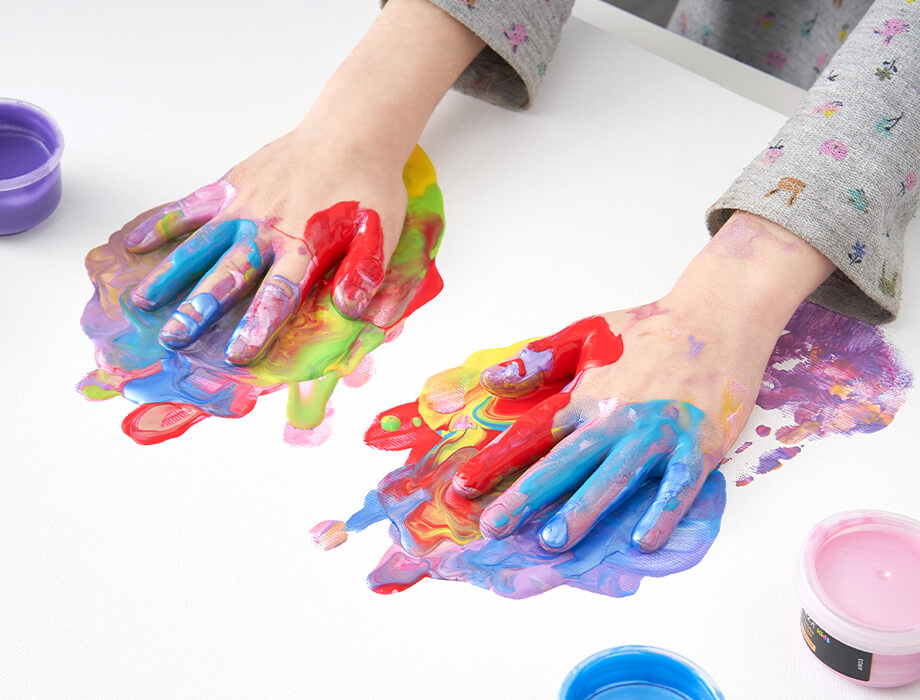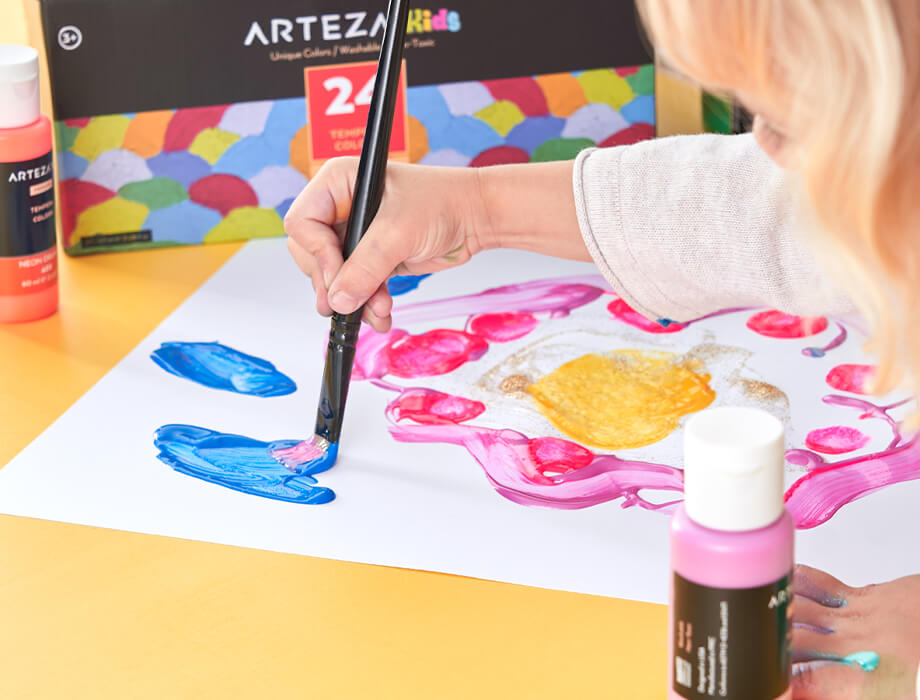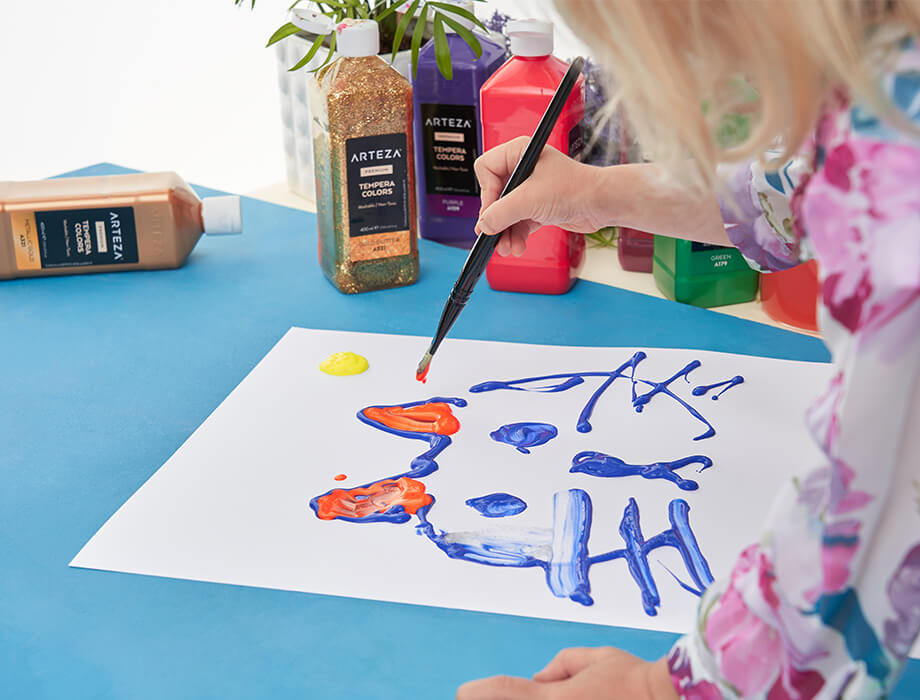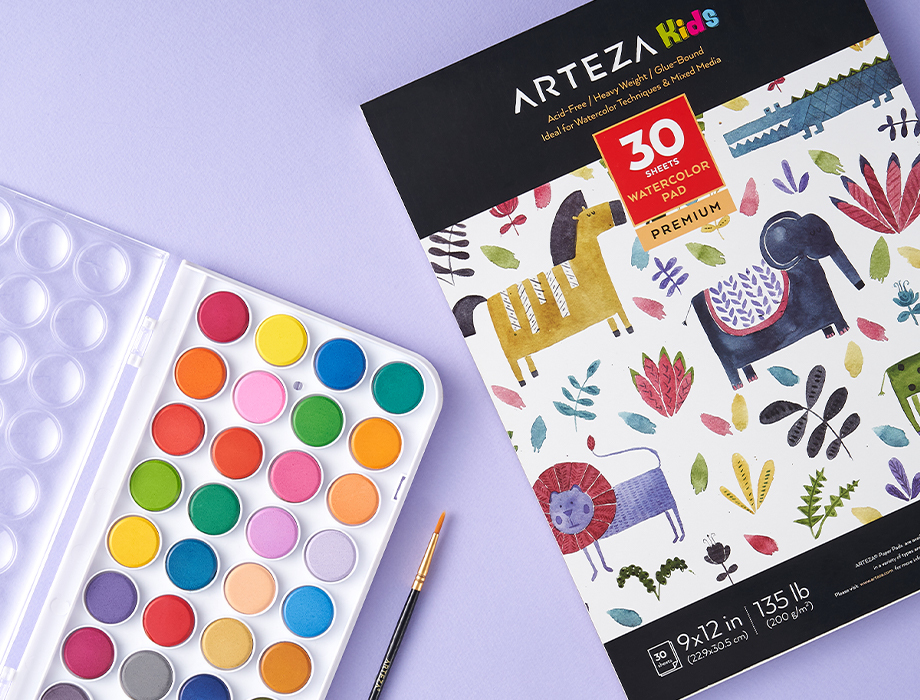Table of Contents:
- Why Art Is Important to Your Child’s Learning Experience
- How Creating Art Improves Learning Skills
- Arty Games & Activities to Build Learning Skills
Why Art Is Important to Your Child’s Learning Experience
School starts soon so now’s a good time to think of ways to make the year more successful for your child. One way to do this is through fun activities that will help build strong learning skills that can be applied to their schoolwork. This is where art comes in.
You might think your child’s artwork is just scribbling or doodling, but those hours spent drawing and coloring are building skills that will enhance learning throughout their life. Since children are naturally inquisitive, art allows them to explore, create and stretch their imagination like no other activity. While they squish and smear fingerpaint, cut and paste pieces of paper to form a picture or draw their family members with a fat crayon, their brain is firing off and forming new connections that will help them with other tasks in the future. Plus, it’s just plain fun!
In this article, we’ll give you some insight into how making art plays an important role in your child’s development. We’ve also included some arty games and activities to get you started adding more opportunities for artmaking into your child’s life.

How Creating Art Improves Learning Skills
Have you ever watched your child’s face as he or she is drawing or painting? Oh, the concentration! Without any preconceived notion of what constitutes “good” or “bad” art, they go all in, concentrating on the colors, the movement and the way the medium acts as they use it. It may look as if they’re playing, but they’re doing important physical, emotional and mental work. Your child’s artmaking is actually strengthening the following skills:
- Fine Motor Skills
Every time your little one puts a pencil or crayon to paper, they’re improving fine motor skills. Any activity that makes a child use the small muscles in the hands and fingers will build these skills. Picking up noodles and pasting them on paper, cutting out pictures with safety scissors, trying to keep the crayon steady enough to color in the lines, all of these actions build the muscles they’ll eventually need to tie their own shoes, button their clothes or brush their teeth.
- Hand-Eye Coordination
Art activities require the brain to connect what we see with what we do. We look at an orange and then try to draw it on a piece of paper. This hand-eye coordination is another important skill that can be improved through art. Building strong hand-eye coordination can benefit a child by making it easy to catch or kick a ball, balance on a beam or put a puzzle together.
- Scientific Skills
Science involves careful observation, the laws of physics and experimentation. By trying to draw the details of the faces of the family or mixing two colors together to get a new one, your child is increasing their scientific skills. Things like perspective, spatial relationships and patterning are also scientific concepts that are used throughout the process of making art. Understanding such concepts as to why things that are closer appear larger than things far away can be more easily understood through drawing pictures.
- Cognitive Development
Cognitive development is the advancement of how we process information and figure things out. Art allows children to freely try new things. It’s one of the few activities that encourage “messy” play, giving a child free rein to explore, manipulate and change things without fear of being scolded. As they see the cause and effect of their actions, it helps them to become better problem solvers and critical thinkers.
- Language Skills
The world of art has its own vocabulary. You can build your child’s language skills by encouraging them to talk about what they are creating and why. By discussing their subject and process, they will be in a better position to use descriptive and explanatory phrasing, as well as new nouns, verbs and adjectives. The names of the colors, the types of media and art supplies they use will also increase their vocabulary for the future as well.
- Social & Emotional Skills
Art can be used to build a child’s positive self-image and establish empathic feelings. Your child’s artwork is a reflection of their unique take on their world. By praising them for their efforts and displaying their art for all to see, you’re reinforcing that your child is special and what he or she creates is of value.
When others, such as friends or family members, share their art with your child, it’s a good chance for them to learn about empathy. Just as they like to have their art acknowledged, you can take these sharing opportunities to have your child acknowledge the work of others.
- Confidence
The more art your child creates and the more you discuss and display it, the more confident they’ll become. Not only will their confidence in their creative abilities become stronger, but their confidence in themselves as individuals will strengthen. Soon they’ll be more confident in seeking solutions to challenges, interacting with others and being able to express themselves.

Arty Games & Activities to Build Learning Skills
We put together a few art activities that will help reinforce the skills we’ve just discussed.
1. Play with clay, draw and paint with fingers
Place some clay, pencils, crayons, paper or paint on a table and let your child mold, draw or create whatever they want. Even a half-hour of art time can yield huge benefits! Finger painting is a great way to encourage your child to express their feelings and strengthen their cognitive development. Pushing the paint around and trying to manipulate it into shapes is a good way for your child to explore new textures and to see how things can be changed.
2. Have your child draw his or her current emotions or feelings
Ask them to draw how they are feeling or to draw what sound, texture, structure, color or taste they are. After they’re finished, ask them about their work with open-ended questions such as why they chose a particular color or shape. This will help them understand their feelings and also strengthen their language skills as they try to find the right words to express themselves.
An ideal medium for this activity is tempera paint. As they paint themselves and how they’re feeling, they’ll also be exposed to color mixing, spatial relationship and perspective. Tempera paints are easy to use, so your child can paint freely, concentrating on expressing how they feel through their artwork.
Once the painting is complete, it’s important to discuss with them the emotion they portrayed in the painting and why they chose to depict it. This will enhance their language skills and present an opportunity to foster good self-esteem.
3. Solve a problem
Give your child an easy life problem, such as a cat stuck in a tree, and ask them to draw the solution. By drawing the solution, they’ll get a chance to think about the different ways problems can be solved as well as gain confidence in making decisions. This activity can be done with a variety of media, including graphite pencils, art markers, brush pens, or paint.

4. Create an experiment
Ask them to draw something, such as a car or a house, the way it will appear 100 years from now. Open-ended art activities like this offer choices that can foster the development of imagination and fantasy in addition to scientific thinking skills. You can use household supplies such as boxes, bins, cans, jars, chalk, tape, scrap paper and more to use for creating this drawing or add as an enhancement. Mixed-media is a creative way of using lots of different things in one picture and can be another way to encourage creative thinking and problem-solving in your child.
5. Draw the book they just read
Whether it’s a favorite storytime character or a comic book superhero, recreating a scene from a book is a great way to help your child develop their memory and language skills. Invite them to talk about their art and why they chose that specific part of the book or character.
To add more fun to this project, why not have your child use watercolor pencils? Not only do they help improve your child’s hand-eye coordination but they’ll be amazed at how easy it is to turn their drawings into paintings by just adding water. This is also another good way to introduce them to scientific skills as they watch the interaction of the water with the pigment and try to maneuver it to create the shades they want.
6. Discuss famous paintings
Looking at the works of famous artists is a good way to expose your child to all the different ways to create. As you show them the paintings, encourage them to talk about what they think about the work, how it makes them feel and what they like or don’t like about it. Letting them know their opinion matters is a good way to build positive self-esteem in your child.
After looking at well-known artists, how about having your child try to replicate one of the paintings they liked best? Or, using the style of the artist, have them make their own piece of abstract, realistic, or impressionistic artwork.
7. Introduce new or unexpected art materials
Your child can create art with all sorts of things. Look around the house and see if you can find alternative art supplies. Maybe they could try painting with a feather or using a rock instead of paper to make a painting on. Let them go on a scavenger hunt and find the most unexpected thing they could use to create their next masterpiece!
Here’s an idea, why not use fuse beads for this activity? These little beads have the potential to make all kinds of designs and are not the usual art material for most kids. By placing them either with their fingers or a tweezer onto a pegboard and baking them to form a solid product, they not only improve their fine motor skills and hand-eye coordination, they get to see scientific principles at work. They’ll also end up with a tangible piece of original art they can display for a big boost of self-confidence!
8. Create titles for their artworks
Giving a title to an artwork is important for a few reasons. By giving your child’s creation a title, you give it stature and emphasize its importance. A title can also help your child articulate what they were trying to express in the work and learn to generalize and combine different ideas into one concise thought.
We suggest your child use watercolors for this activity. Watercolor doesn’t require any smelly solvents and it’s easy to clean up once they’re done. It also reacts in many different ways depending on the surface moisture, the amount of water added and the kind of strokes made. The potential for color mixing, layering and blending is endless and will give your child more reason to explore its uses and expand their creativity.
At Arteza, one of our goals is to give you all the tools, inspiration and motivation you need to bring the joy of creating to your children. We hope this article has helped you learn more about how art can complement your child’s development and learning experiences. Allowing children to do what they do best—explore, play, imagine—through artmaking is sure to help them as they go through school and grow into adulthood. We’d love to know how you’re incorporating more art into your child’s life by leaving us a comment in the section below.


















1 comment
When I see this article: YESSSSSSSSSSSSS
:D